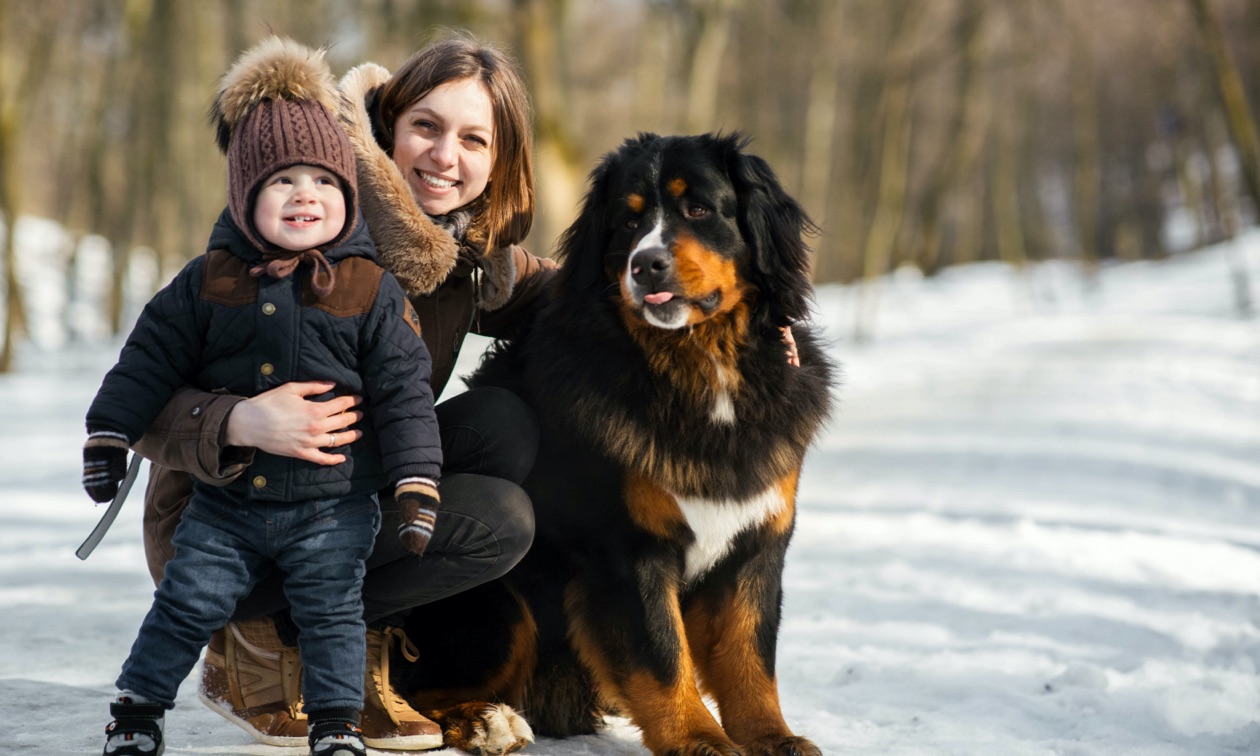If you live in a cold climate (even for just part of the year), it’s important to keep in mind how that weather will affect a new dog joining your family. Simply relocating to a colder area can impact your current dog as well. If you’re debating what breed of dog to add to your life or whether your dog is suited for a colder climate, consider whether they have natural defenses for chilly weather.
Cold Weather Dogs Have Thick Double Coats
Dog fur comes in a variety of types — curly, straight, wiry, soft, and more. Dogs with short and thin coats (or none at all) have a harder time regulating their body temperature and staying warm during cold weather.
Look for a breed with a thick double coat if you’re in a cold climate. This means they have an underlayer of dense and soft fur (called the undercoat) as well as the tougher and longer outer layer of guard fur. That undercoat acts a lot like a down jacket, keeping them toasty warm by insulating their body, while the outer layer repels moisture to keep the undercoat dry.

Examples of breeds with a double coat that are well-suited to cold weather include:
Look at breeds whose lineage is based in cold climates. For example, the Siberian Husky and the Malamute originated as sled dogs in Russia and Alaska, meaning they often had to work in extreme, below-zero temperatures. The Bernese Mountain Dog, the closely related Swiss Mountain Dog, and the Saint Bernard were bred to work in the cold mountains of Europe. By looking at the history of the breed you’re considering, you’ll get a better idea of whether their natural coat is made for handling cold weather.
You might notice that the Spitz-type breeds, such as Chow Chows, Akitas, and Pomeranians all tend to have that fluffy double coat that makes them a good choice for cold climates. However, some terriers have a nice double coat to keep them warm, such as Tibetan Terriers, Norfolk Terriers, and Scottish Terriers. If the idea of lots of shedding and constant vacuuming makes you cringe, investigate terrier breeds that have a nice wiry outercoat that protects their soft undercoat.
While dogs with curly coats, such as Poodles, retriever-Poodle-mix, Doodles, or Portuguese Water Dogs, may look like they have a thick coat meant for cold weather, their curly coat is a single-layer coat, meaning there is no undercoat to act as insulation from the cold. While this coat type helped them working as water retrievers and hunting dogs, it doesn’t do much when it comes to chilly temperatures.
What Size of Dog Does Best in Cold Weather?
Beyond the type of coat a dog has, their size can play a role in how easy it is for them to stay warm. Smaller dogs lose body heat faster than larger dogs thanks to the ratio of their larger surface area to their volume. Small dog breeds are also closer to the ground, exposing their bellies and bodies to the cold surface or snow much more than longer-legged dogs. If you’re searching for a small dog that does well in cold weather, look primarily to their coat type to ensure they have the best insulation.
Age Affects How Well Dogs Handle the Cold
Puppies and senior dogs don’t handle cold temperatures as adult dogs can. They can’t regulate their body temperature at these ages like they can when in the prime of life. If you’re bringing home a puppy or adopting a senior dog, pay attention to the temperature outside and take extra precautions during cold weather.
How Cold Is Too Cold for Dogs?
A general guideline for when to worry about cold temperatures for your dog is 45 degrees Fahrenheit. At this temperature, dogs not built for cold weather can feel uncomfortable.
Anytime the thermometer drops below freezing at 32 degrees, dogs with thin coats, puppies, senior dogs, and small breed dogs should be bundled up and monitored when outside in the cold.
Temperatures below 20 degrees require owners of all dog breeds (no matter their coat type) to take care to ensure they are protected from hypothermia and frostbite. Even for some of the best dogs for cold weather climates, like Siberian Huskies, who are conditioned to work in these extreme temperatures, it’s still important to monitor for signs of cold exposure and frostbite.
Keep in mind that even if your dog’s breed is one initially developed to work in cold temperatures, your dog’s individual experience will also influence their ability to tolerate cold temperatures. If your dog isn’t used to being outside in cold weather, cold weather exposure should be limited, supervised, and introduced gradually for any dog.
Signs of cold exposure and hypothermia in dogs include:
- Shivering
- Lethargy or moving slowly
- Low heart rate
- Slow breathing rate
- Pale or gray gums
- Stiff muscles
- Lack of coordination or stumbling when walking
- Fixed and dilated pupils
- Collapse
Typically, as hypothermia progresses, the severity of the symptoms becomes obvious. As dogs try to conserve their body temperature, they become less responsive. They are trying to keep their vital organs working by restricting blood flow to other parts of their body. Hypothermia can be fatal if not treated.
Invest in Cold Weather Dog Protection
If you’re in love with a breed that isn’t built for coping with the cold, you’ll want to think about ways you’ll keep your new pup nice and toasty when it’s cold outside. Even for dogs who can handle colder temperatures, you should still protect their vulnerable paws and noses from the harsh weather.
Dog Boots
Training your dog to wear dog booties helps keep feet warm and dry when walking in the cold or snow. Choose a dog boot made specifically for cold weather that has traction for slippery surfaces.
Dog Jackets or Sweaters
Bundling up small dogs, young or senior dogs, and those with short fur coats is important to conserve body heat. There are lots of options out there for dog outerwear. First, look for insulation and then for waterproof materials. If you live in a wet and cold climate, you can layer a fleece jacket under a waterproof jacket to keep your dog warm and dry.
Nose and Paw Wax
Cold air can chap a dog’s nose, just like it can chap our lips and skin. Apply nose wax to protect your dog’s nose when going on outdoor adventures in the cold. These protective waxes can also be used on your dog’s paw pads to help prevent snow and ice build-up between their toes and protect their pads.
ZPC-01529R1



